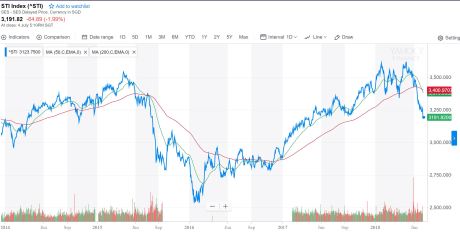
Markets have been hit. Are you worried?
So, in February I wrote this:
I’m not out of the markets because I believe timing it is a futile exercise but I moved more money to cash/bonds as valuations got higher. In fact, I stopped buying anything after Feb last year.
This week, no thanks to the government increasing the Additional Buyer Stamp Duty (ABSD) on the sale of property, the markets fell roughly 2% on Friday alone. The STI is now down some 268 points or roughly 8% from the start of the year. From the highs of 3,577 reached in April, the market is now down 11.7% which puts us firmly in correction territory.
As mentioned in my February post, I stopped buying into the markets since February of 2017 as things were getting expensive and I basically enjoyed the ride up. I also started trimming some positions towards the end of 2017 as markets climbed. Selling UMS at what was nearly the peak for it netted some accounts a nice profit.
In case, you’re thinking that I made out nicely, I haven’t.
A couple of stupid decisions, like not selling Venture at its peak (I actually placed the order to sell it at $28 but it didn’t get filled) and not selling Starhub at all (this could be one for the history books) meant that my portfolio has been hammered somewhat. Not knowing when to sell has been one of my weak points and still continues to haunt me.
However, what I’m much better at is knowing when to buy. Thankfully, I’m (relatively) young and therefore being a net buyer is still the right way to go. By all the measures that I’m tracking (e.g. CAPE for the STI, difference between PE10 yields and the 10 year government bond, and some trend indicators), it appears that a buying opportunity is starting to appear.
A word of caution. Things are NOT dirt cheap based on valuations. We have seen cheaper valuations in late ’08-09 as well as ’16-early ’17. What many people don’t realise is that the market was much cheaper in early ’17 compared to mid ’10-’11 despite them being roughly at the same levels. This is because earnings had risen from 2011 to 2017 while prices barely rose.
This is the mistake that my senior colleague made. He was anchored on the price of the market and therefore, a level of 3,000 looked expensive to him in early 2017. This caused him to basically miss out on the upswing in markets in 2017.
If you think things are going to be as bad as they were in 2009, then based on current normalised earnings, the STI should bottom out somewhere around the 2,700 level. Expecting the STI to hit 1,500 as it did in the depths of the Global Financial Crisis is expecting the market to be hit CAPEs of 6x! That’s probably even lower than levels during the Asian Financial Crisis.
What do you all think? Let me know in the comments below.

[…] As always, you can’t react to things when a recession or a bear market comes, you already need a plan before these things […]
Short positions
The STI is down roughly 8% YTD. Do you have a plan? | Ryan Goh: Life through these eyes
Tire Pressures
The STI is down roughly 8% YTD. Do you have a plan? | Ryan Goh: Life through these eyes
Corporate proxy solicitation companies Hiring
The STI is down roughly 8% YTD. Do you have a plan? | Ryan Goh: Life through these eyes
[…] wrote about having a plan back in July although I didn’t really go into any details about my plan. Right now, the STI is down […]